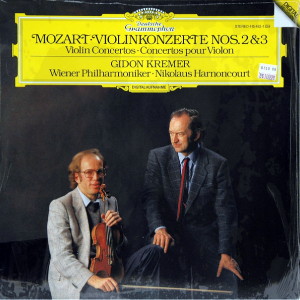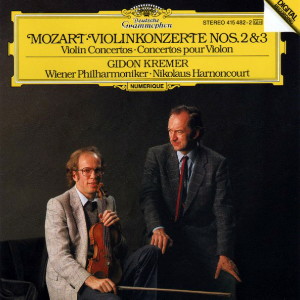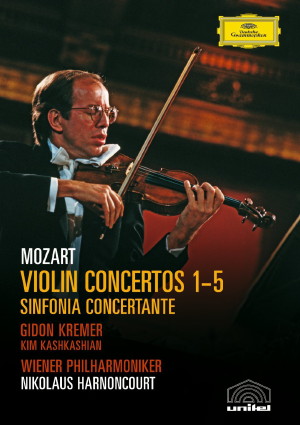 |
1 LP -
415 482-1 - (p) 1986
|
 |
| 1 CD -
415-482-2 - (p) 1986 |
 |
| 2 DVD -
0440 073 4157 5 - (c) 2006 |
|
| Wolfgang
Amadeus Mozart (1756-1791) |
|
|
|
|
|
|
|
| Konzert für Violine und
Orchester Nr. 2 D-dur, KV 211 |
|
19' 24" |
|
- Allegro moderato
|
7' 58" |
|
A1
|
- Andante
|
7' 03" |
|
A2
|
- Rondeau. Allegro
|
4' 23" |
|
A3
|
Konzert
für Violine und Orchester Nr. 3 G-dur,
KV 216
|
|
23' 53" |
|
- Allegro
|
9' 17" |
|
B1
|
| - Adagio |
7' 57" |
|
B2
|
| - Rondeau. Allegro |
6' 39" |
|
B3
|
|
|
|
|
| Gidon
Kremer, Violine |
|
|
|
| WIENER
PHILHARMONIKER |
|
| Nikolaus
Harnoncourt, Dirigent |
|
|
Luogo
e data di registrazione
|
Grosser
Saal, Musikverein, Vienna (Austria) -
dicembre 1984
|
|
Registrazione
live / studio
|
| studio |
Producer
/ Engineer
|
Hanno
Rinke
|
Prima Edizione CD
|
| Deutsche
Grammophon - 415 482-2 - (1 cd) - 43'
17" - (p) 1986 - DDD |
Prima
Edizione LP
|
Deutsche
Grammophon - 415
482-1 - (1
lp) - 43'
17"
- (p) 1986
- Digital
|
Edizione
DVD
|
| Deutsche Grammophon - 0440 073
4157 5 - (2 dvd) - 92" 00" + 61' 00" -
(c) 2006 - GB |
|
|
Notes
|
The two
violin concertos
in this recoeding have
much in common; they
were written in the same year, in the
productive summer of
1775, and in the same place; the tilee-page
of the autograph of the D major Concerto
K. 211 is inscribed in the composer's
hand. "Concerto di Violino
di Wolfgango Amadeo
Mozart mp. à salzburg li 14
di giugno 1775", and the G major Concerto K.
216 followed only three months later.
The two manuscripts shared the same
eventiful history;
their value being enhanced by the fact
of their being complete, they vanished
after the fall of Berlin in 1945 and for
many years they were believed
destroyed, until
they surfaced again in the late 1970s
in the Biblioteka Jagiellónska in Kraków.
In 1983 they were
published in the New Mozart Edition,
edited by Christoph-Hellmut Mahling.
In 1775 Mozart was
still concert-master
in the employment of
the Prince-archbishop of
Salzburg, and
many of the compositions
of the peirod were
written to meet
the demand of this post and
to provide new works for the
instrument with which he earned his
salary. Much as he enjoyed playing
concertos by other violinists - in
Augsburg in 1777 he played one by
Hohann Baptist Vanhal, for example -
he nevertheless wrote his violin
concertos with his own style of
playing uppermost in his mind. To his
father, who was himself a violinist
and also his teacher, he wrote from
Munich: "I played as if I was the
greatest violinist in all Europe" (6
October 1777). There
is no mistaking
the pride expressed in another letter
to Leopold, from Augsburg. reporting
that “everyone
praised the beautiful, pure
tone", and adding, with a deceptively
casual air, that he
lied performed "to general applauso"
(25 October 1777).
What was Leopold Mozart's
reaction? As a teacher he was pleased,
but his son’s unconcealed
preference for the
piano was a
disappointment to him. On his Italian
tours, especially the third,
Wolfgang had plenty of opportunity to
study concerto form
on its native soil. Vivaldi's concertos
were still widely performed,
and established the norm,
both in the number of movements -
three - and in the
relationship of tuttis and solos. But
unlike Vivaldi's own
often schematic response to the
requirements of the form,
each one of Mozart's violin
concertos has "an
individual personality", as
Mahling says.
The D major Concerto K. 211 does not
make very great demands on the
soloist; its primary requirement is
for a perception of the music as
"conversation galante", in which the
soloist's role is to adopt poses, make
bows, emit sighs, engage in graceful
dialogue with the orchestra, speaking
the while in accents which emulate
those of "natural" speech. The
orchestral texture - two oboes,
two horns and strings
- is wholly in keeeping
with the unemphatic elegance of music
for an 18th-century court, in an idiom
familiar to us from countless
divertimentos and other occasional
compositions of the 1770s. To place K.
211 at the side of the G major
Concerto K. 216 is to be made aware at
once of the greater profundity of this
well-loved work, of the greater
maturity of its slow movement, of the
effectiveness of its apparently
undemonstrativequiet close, in place
of a barnstorming tutti blatantly
soliciting applause. The motive which
launches the Allegro is simultaneously
galant and insistent, and with its
characteristic alternation of forte
and piano is markedly
reminiscent of an aria for Aminta in Il
re pastore, the dramma per
musica composed in april of the
same year. In the
Adagio, while the
muted orchestral violins keep
up their murmuring and the loer
instruments a serenade-like
pizzicato, the solo violin soars
dreamily above them, with a
sweetness unknown before this. The
Rondeau (Allegro), with a cheerful
theme in 3/8, breaks off for an
Andante serenade, complete
with a guitar-like
accompaniment. This leads on into a
light-hearted folksong theme, with an
unmistakable resemblance to Willem
von Nassau. The soft conclusion,
seeming to fade away as the young
composer is overcome by melancholy, is
strangely touching.
Roland Würtz
Translation: Mary Whittal
|
|
Nikolaus
Harnoncourt (1929-2016)
|

|

|
|